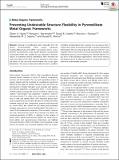Files in this item
Preventing undesirable structure flexibility in pyromellitate metal organic frameworks
Item metadata
| dc.contributor.author | Hayes, Oliver G | |
| dc.contributor.author | Warrender, Stewart James | |
| dc.contributor.author | Cordes, David B. | |
| dc.contributor.author | Duncan, Morven J. | |
| dc.contributor.author | Slawin, Alexandra M. Z. | |
| dc.contributor.author | Morris, Russell E. | |
| dc.date.accessioned | 2020-05-28T12:30:02Z | |
| dc.date.available | 2020-05-28T12:30:02Z | |
| dc.date.issued | 2020-07-15 | |
| dc.identifier | 267778109 | |
| dc.identifier | abe68e3c-abd7-4cf4-bb62-8c46405f5f70 | |
| dc.identifier | 85085569353 | |
| dc.identifier | 000535628900001 | |
| dc.identifier.citation | Hayes , O G , Warrender , S J , Cordes , D B , Duncan , M J , Slawin , A M Z & Morris , R E 2020 , ' Preventing undesirable structure flexibility in pyromellitate metal organic frameworks ' , European Journal of Inorganic Chemistry , vol. 2020 , no. 26 , pp. 2537-2544 . https://doi.org/10.1002/ejic.202000322 | en |
| dc.identifier.issn | 1434-1948 | |
| dc.identifier.other | ORCID: /0000-0002-9527-6418/work/74872893 | |
| dc.identifier.other | ORCID: /0000-0002-5366-9168/work/74872966 | |
| dc.identifier.other | ORCID: /0000-0001-7809-0315/work/74872969 | |
| dc.identifier.uri | https://hdl.handle.net/10023/20005 | |
| dc.description | This project has received funding from: the European Union's Horizon 2020 research and innovation program under grant agreement No 685727; the Engineering & Physical Sciences Research Council (EPSRC) under awards EP/K005499/1 and EP/K039210/1; and the University of St Andrews School of Chemistry. | en |
| dc.description.abstract | Removal of coordinated water molecules from the porous Zn‐pyromellitate metal organic framework Zn5(OH)2(PMA)2(H2O)4 · x H2O (PMA = pyromellitic acid or 1,2,4,5‐benzene tetracarboxylic acid) should generate coordinatively unsaturated metal sites suitable for gas adsorption. However, reports of instability towards dehydration have restricted the study and utility of this MOF. Here we examine in more detail the nature of the structural transformation that occurs upon dehydration. This study reveals that a fully reversible crystalline‐crystalline transformation from a porous to a non‐porous homologue takes place, proceeding through a partially dehydrated intermediate. We show that doping the structure with Ni2+ ions at greater than 30 % prevents structural rearrangement, thereby maintaining porosity, and rendering the material effective for gas (nitric oxide) adsorption applications. These results indicate that doping can be an effective means to increase the utility of otherwise unserviceable structures. | |
| dc.format.extent | 8 | |
| dc.format.extent | 1873977 | |
| dc.language.iso | eng | |
| dc.relation.ispartof | European Journal of Inorganic Chemistry | en |
| dc.subject | Crystalline-crystalline transformation | en |
| dc.subject | Doping | en |
| dc.subject | Metal-organic frameworks | en |
| dc.subject | Nitric oxide | en |
| dc.subject | Structure elucidation | en |
| dc.subject | QD Chemistry | en |
| dc.subject | DAS | en |
| dc.subject.lcc | QD | en |
| dc.title | Preventing undesirable structure flexibility in pyromellitate metal organic frameworks | en |
| dc.type | Journal article | en |
| dc.contributor.sponsor | EPSRC | en |
| dc.contributor.sponsor | EPSRC | en |
| dc.contributor.sponsor | European Commission | en |
| dc.contributor.institution | University of St Andrews. School of Chemistry | en |
| dc.contributor.institution | University of St Andrews. EaSTCHEM | en |
| dc.identifier.doi | 10.1002/ejic.202000322 | |
| dc.description.status | Peer reviewed | en |
| dc.identifier.grantnumber | EP/K005499/1 | en |
| dc.identifier.grantnumber | EP/K039210/1 | en |
| dc.identifier.grantnumber | 685727 | en |
This item appears in the following Collection(s)
Items in the St Andrews Research Repository are protected by copyright, with all rights reserved, unless otherwise indicated.

